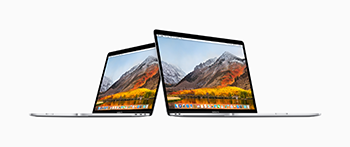
Apple's July 2018 MacBook Pro release is evolutionary rather than revolutionary, but does some bring some relevant changes.
The system I've been testing is a Slate Gray MacBook Pro 13-inch with Touch Bar. The particular configuration includes a 2.3 GHz Intel Core i5 processor (8259U with four cores and Turbo Boost up to 3.8 GHz), 16 GB of DDR3 RAM, and a 512 GB SSD. Graphics are Intel's Iris Plus Graphics 655.
Though the MacBook Pro's chassis is the same, there are improvements other than the new Intel processors. Apple has modified the much-criticised keyboard with silicone covers under each key that are designed to quiet typing and keep foreign material from getting inside. A T2 chip (first seen in the iMac Pro) integrates the System Management Controller, the image signal processor, the audio controller, and the SSD controller. The Retina display now supports True Tone technology, which automatically adjusts the display's white point. Finally, this generation moves from Bluetooth 4.2 to Bluetooth 5.0.
Many features and specifications are entirely unchanged. The port layout and capability of the USB and Thunderbolt connections remains the same. WiFi standards support is also unchanged. As might be expected, the weight remains about the same.
There have been reports of issues specific to the new MacBook Pros. There was an early overheating problem with Core i9 versions of the 15-inch, but Apple seems to have solved that with a firmware patch. There's also an issue with crackling speakers that may be related to the combination of using Hey Siri and the presence of the T2.
My test unit has run generally well, with only two observed concerns. I've had three hard crashes in a month while running the current version of Google's Chrome browser, though that may not be specific to the new system. The other one is definitely specific—the system often gets quite hot, with both fans kicking in loudly. This condition may be a result of the increased Thermal Design Power (TDP) of the new processor, but it's a notable difference from the 2016 version of the same system.
What can we expect for future notebooks from Cupertino? The driver toward thin and light—which Apple started with the PowerBook G4 in 2001—is almost entirely played out, with few gains remaining without substantially affecting usability (and some would argue Apple has already done that). Apple's Windows-based competitors have gone with physical flexibility, adding 2-in-1 and tablet configurations to their notebooks, while Apple continues with the now classic clamshell as the only configuration for mobile macOS system.
There are strong rumors of new entry-level systems from Apple coming this fall, but it would be somewhat surprising to see them release a system that substantially overshadowed the more expensive (and money-making) MacBook Pros.
John Mulhern III, Posted 8/25/2018



